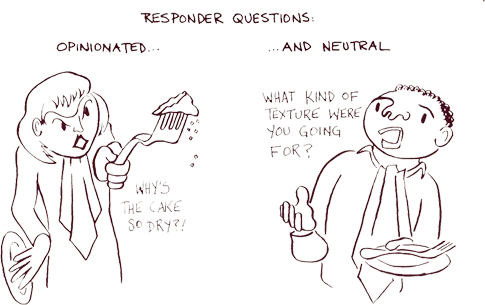The Critical Response Process follows four core steps and includes three roles artist, responders, and a facilitator.
THE ROLES:
• The artist offers a work-in-progress for review and is prepared to question that work in a dialogue with other people.
• Responders (one, a few, or many), committed to supporting the artist's intent to make excellent work, engage in dialogue with the artist.
• The facilitator initiates each step, keeps lhe process on track, and works to help the artist and responders use the process to frame useful questions and responses.
THE CORE STEPS:
Step One; Statements of Meaning
No matter how short thepresentation, how fragmentary the excerpt, or how early the stage of development, artists want to hear that what they have just completed has significance to another human being. So the facilitator starts step one by asking
the responders: "What has meaning for you about what you have just seen?" or "What was stimulating, surprising, evocative, memorable, touching, unique, compelling, meaningful for you?" The point is to offer responders a palette of choices through which to define and express their reactions.
Step Two: Artist as Questioner
In this step, the creator asks the questions. The more that artists can clarify their focus, the more intense and deep the dialogue becomes. General questions often elicit more varied responses. Specific questions, naturally, bring forth a more focused and precise commentary. Both can be helpful. Here the facilitator may need to probe with more questions—not answers—to help the artist find the heart of the matter.
Step Three: Responders Neutral Questions
The dialogue is now reversed, and responders can ask the artist informational or factual questions. Further, if they have opinions, responders can take this opportunity—in advance of stating the opinion in step four—to form the opinion into a neutral question.
For many people, forming a neutral question is not only difficult but a seemingly ridiculous task if criticism is the point. But the practice of trying to form opinions into neutral questions enables the responder to recognize and acknowledge the personal values at play. Often these are the very questions that the artist needs
to hear.
Step Four: Permissioned Opinions
Now the facilitator invites opinions, with a particular protocol: Responders first name the topic of the opinion and ask the artist for permission to state it. For instance, "I have an opinion about the costumes. Do you want to hear it?" The artist has the option to say "yes" or "no." The artist may have several reasons for not wanting to hear the opinion: Perhaps he has already heard enough opinions about the costumes and wants to move to something else; perhaps he is very interested in hearing about the costumes but not from that responder; or perhaps the opinion is irrelevant for the ultimate performance. In every case, artists bave the option to say "no," or "not rigbt now." In most cases, however, tbe artist will say "yes," because the Process has laid the groundwork for this moment.
The step may seem formal, but often tbe formality, discipline, and structure inherent in the process make it safe for people to go into a more challenging dialogue.
Text aus: o.A.: Liz Lerman's Critical Response Process. |


 Abb. 8)
Abb. 8) Abb. 9)
Abb. 9)


